The Silent Destroyer: Why White Grubs Are a Farmer's Worst Nightmare
White grubs are a common and destructive pest that can wreak havoc on a wide range of crops and landscapes. These C-shaped, creamy-white larvae are the immature stage of scarab beetles, including the well-known May/June beetles, Japanese beetles, and chafers. While the adult beetles are often harmless leaf feeders, it's the grubs' insatiable appetite for plant roots that causes the most significant damage.
The Family: Scarabaeidae
White grubs are the larvae of beetles belonging to the family Scarabaeidae, commonly known as scarab beetles. This is a vast and diverse family, with over 30,000 species worldwide, including dung beetles, chafers, rhinoceros beetles, and flower beetles.
The grubs themselves are not a single species but represent the immature stage of many different scarab beetles. The most common species whose larvae are considered major pests include:
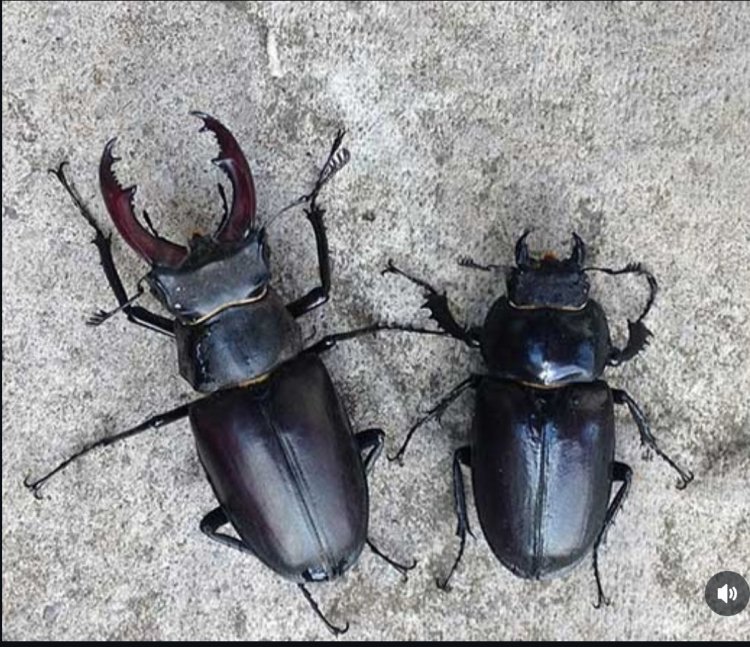
* June Beetles (or May Beetles): Larvae of the Phyllophaga genus.
* Japanese Beetles (Popillia japonica): A highly destructive invasive species in many parts of the world.
* European Chafers (Rhizotrogus majalis).
* Masked Chafers (Cyclocephala species).
Physical Characteristics of the Grub
While the adult beetles vary greatly in appearance, the larvae, or grubs, share several key characteristics that make them easily identifiable.
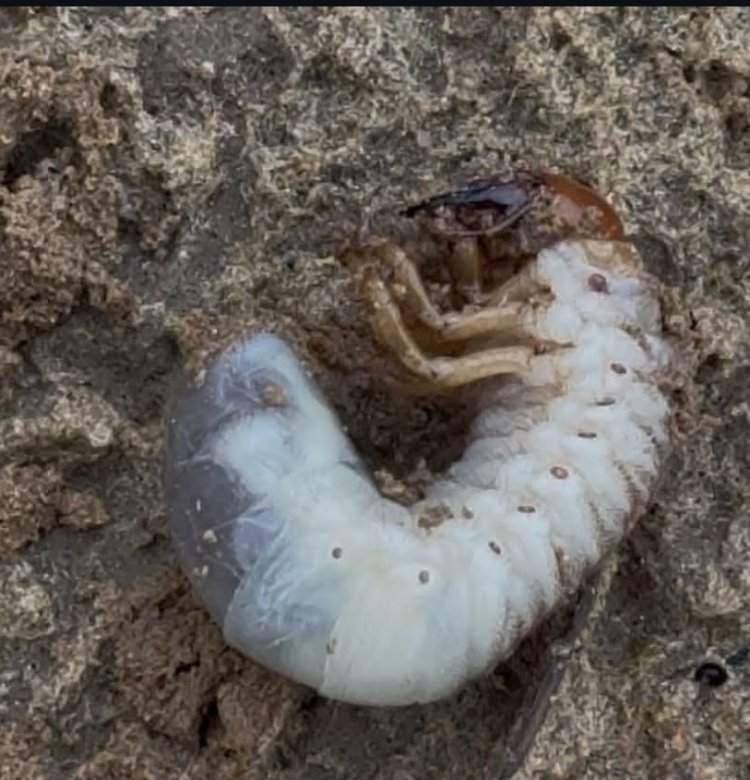
* Shape and Color: They have soft, creamy-white bodies and are typically found curled into a distinctive "C" shape.
* Head: They have a prominent, reddish-brown or tan head.
* Legs: They possess three pairs of short, spiny legs on the thorax, just behind the head.
* Size: The size of a grub can vary significantly depending on the species and its stage of development, ranging from a quarter-inch to over an inch long.
Detecting a Root Grub Infestation
Detecting a root grub infestation early is essential for effective management. Here are some key indicators that can help you identify if root grubs are present:
* Wilting or Yellowing Plants: Plants that are infested with root grubs often look wilted, yellow, or have browning leaves because their compromised roots can't absorb enough water and nutrients.
* Stunted Growth: If your plants don't seem to be growing as expected or are smaller than usual, it may be a sign of root grub damage.
* Increased Animal Activity: You might notice an increase in animals like birds, raccoons, and skunks in your garden. They're often drawn to the area to feed on the root grubs in the soil, and this increased activity can signal an infestation.
* Presence of Adult Beetles: Spotting a large number of adult beetles, such as Japanese beetles or June beetles, in your garden could indicate the presence of root grubs, as these are the adult stage of the pest.
Life Cycle: A Monthly Breakdown
The white grub's life cycle is a fascinating yet destructive annual process, primarily spanning the warmer months. Understanding this cycle is crucial for effective control, as the timing of treatment is critical.
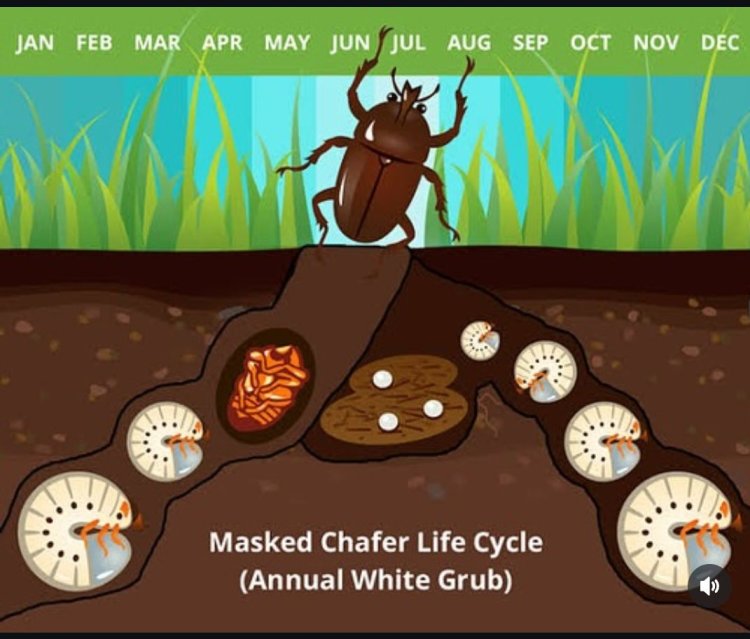
Stage 1: Adult Emergence and Egg-Laying
May - June: - This is when the adult beetles, such as the May/June beetles, Japanese beetles, and chafers, emerge from the soil. They are attracted to lush, well-watered areas. The adult stage is relatively short, lasting only a few weeks. Their main goal is to feed on foliage and reproduce. After mating, the female beetles burrow into the soil, 2-6 inches deep, to lay their eggs.
July: - Eggs, which are small and milky-white, hatch within 2 to 3 weeks. This marks the beginning of the larval stage, where the tiny grubs emerge and begin to feed.
Stage 2: The Larval (Grub) Stage
The larval stage is the longest and most damaging part of the life cycle. The grubs go through three instars (molts), with each one growing larger and more destructive.
August: - The newly hatched first instar grubs are small, about 1/4 inch long. They immediately begin feeding on the fine, tender roots of plants. The damage at this stage is minimal and often goes unnoticed.
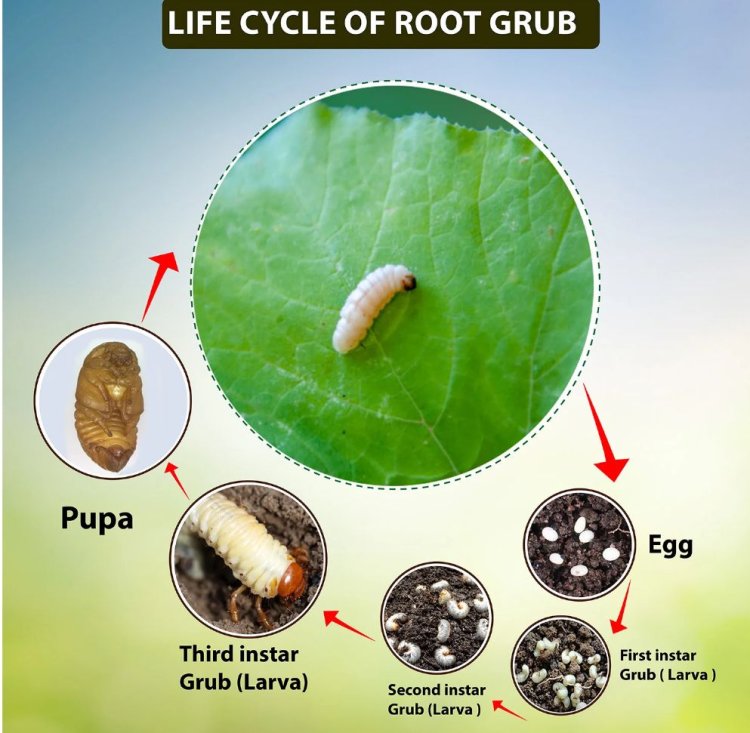
September: - The grubs molt into the second instar. They grow to about 1/2 inch in length and their appetite increases significantly. This is when you may start to notice the first signs of damage, such as wilting or yellowing patches in your lawn or crops.
October: - The grubs molt for the last time, becoming the third instar. This is the most destructive stage. They can grow up to 1 inch long and are voracious feeders, capable of severing entire root systems. The classic symptoms of a severe infestation—like dead, spongy patches of grass that can be rolled up like a carpet—become very apparent now.
November- March: - As temperatures drop, the grubs stop feeding and burrow deep into the soil (up to 2 feet) to overwinter below the frost line. They remain in this dormant state, waiting for the soil to warm up.
Stage 3: The Pupal Stage
April: - As the soil warms, the grubs move back up toward the surface. They may feed for a short period before transforming into the pupal stage. This is a non-feeding, transitional period where the grub metamorphoses into the adult beetle.
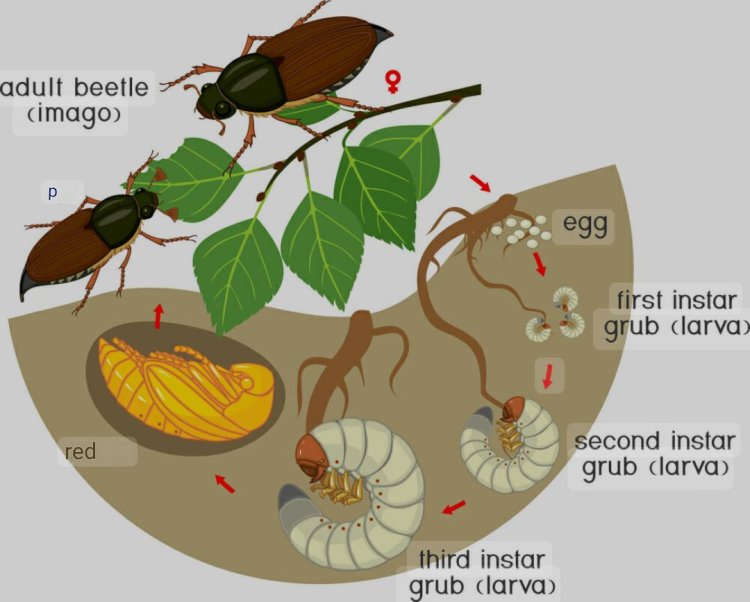
Stage 4: Adult Emergence
May: - The pupae complete their transformation, and the adult beetles emerge from the soil, ready to begin the cycle anew.
Knowing this detailed timeline allows farmers and gardeners to target the most vulnerable stages of the pest. Applying preventative insecticides in July and August is highly effective, as it kills the small, newly hatched grubs before they can cause significant damage.Their active life is often brief, lasting only a few weeks, during which they feed on foliage and focus on mating to continue the next generation of grubs.
Broad-spectrum overview of crops damaged by white grubs
1. Cereal Crops
These are among the most heavily affected due to their extensive root systems, which are a prime target for grubs.
* Maize (Corn): White grubs are a major pest of maize. They feed on the root system, leading to stunted growth, wilting, and in severe cases, the death of young plants. This can result in poor crop stands and significant yield losses.
* Wheat, Barley, and Millets: These crops are also highly susceptible to grub attacks, which can lead to poor plant establishment and reduced grain yield.
* Rice: In some regions, white grubs can be a problem in paddy fields, especially during the non-flooded periods.
2. Legumes and Oilseeds
Grubs can cause substantial damage to these crops, particularly to their root systems and subterranean pods.
* Groundnut (Peanut): Groundnut is a classic example of a crop severely affected by white grubs. They feed on the roots and pods, making them vulnerable to rot and destroying the market value of the harvest.
* Soybean: While not as susceptible as groundnut, soybean can also be damaged, especially in fields that had a previous history of sod or grass cover.
* Sunflower and Sesame: Grubs attack the roots of these plants, leading to wilting and stunting.
* Pulses (like Mung and Tur): Young seedlings are particularly vulnerable to grub damage, which can lead to plant death and reduced crop density.
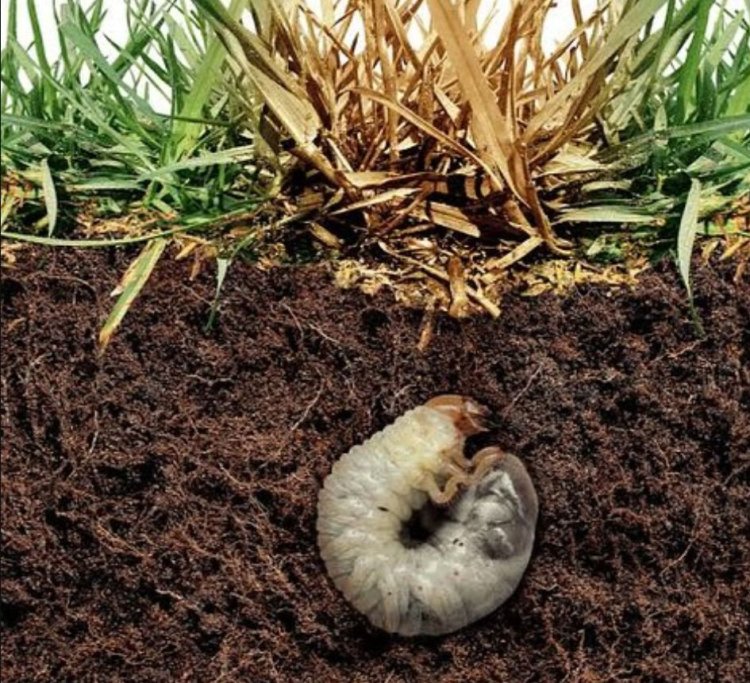
3. Tuber and Root Crops
These crops are directly targeted by grubs, as the grubs not only feed on the roots but also bore into the main product.
* Potato: White grubs are notorious for damaging potato tubers, creating large, circular holes that render them unmarketable. This can lead to significant economic losses for farmers.
* Sweet Potato and Cassava: Grubs feed on the roots and tubers, reducing their size and quality.
4. Plantation Crops
White grubs are a long-term threat to perennial plantation crops, where their continued feeding can lead to gradual decline and eventual death of the plants.
* Sugarcane: This is one of the most economically important crops damaged by white grubs. They feed on the roots and the base of the shoots, causing yellowing, wilting, and easy lodging of the canes.
* Arecanut, Coconut, and Cashew: Grubs attack the root systems of these trees, leading to stunted growth and reduced nut or fruit production.
* Tea and Coffee: In some regions, grubs are a pest of tea and coffee plantations, damaging the root systems and affecting the overall health and productivity of the bushes.
5. Vegetables
A wide variety of vegetable crops are at risk, with damage often occurring at the seedling or root-formation stage.
* Chilli, Brinjal (Eggplant), Tomato, and Cucurbits: Grubs damage the roots, causing wilting and poor plant vigor.
* Onion and Garlic: Grubs can feed on the bulbs, leading to plant collapse.
6. Fruit Crops and Trees
While often considered minor pests of fruit crops, white grubs can cause significant damage, especially in orchards with a history of grass cover.
* Mango, Guava, Grapes, and Apple: Grubs feed on the roots of young trees, which can stunt their growth and, in severe infestations, lead to plant death. The adults of some species can also cause defoliation.
7. Turfgrass and Nurseries
Grubs are a major pest of turfgrass, lawns, and golf courses.
* Lawns and Turf: They feed on the roots of grasses, causing irregular, dead, brown patches that can be easily lifted or rolled back, as the root system has been completely severed.
* Nursery Stock: Grubs can damage the roots of young ornamental trees and shrubs in nurseries, affecting their growth and salability.
In summary, the broad-spectrum damage by white grubs is a global concern, affecting key food and cash crops. Their subterranean life and ability to cause widespread, often unnoticed, root damage make them a formidable challenge for farmers.
Managing white grubs is a multi-faceted challenge that requires a comprehensive, broad-spectrum approach. Since the pest has distinct life stages—from adult beetles to destructive larvae—effective control depends on using the right method at the right time.
Effective control measures of white grub
A successful strategy integrates biological, chemical, and mechanical controls to reduce the grub population at every possible opportunity.
1. Biological Control
Biological control uses living organisms to fight the pest, offering a safe and sustainable solution. It's most effective against the larval stage.
* Entomopathogenic Nematodes (EPNs): These are microscopic, soil-dwelling roundworms that are natural parasites of white grubs. They are a powerful tool against the first and second instar grubs (late July to September).
* How they work: EPNs, such as Heterorhabditis bacteriophora and Steinernema species, are applied to the soil. They actively seek out grubs, enter their bodies, and release a symbiotic bacterium that kills the grub within 24-48 hours. The grubs turn a reddish-brown color after infection.
* Application: Apply EPNs to moist soil, preferably in the evening or on a cloudy day, as direct sunlight can harm them. The soil should be kept moist for several days after application to allow the nematodes to move and infect the grubs.
* Entomopathogenic Fungi: Fungi like Metarhizium anisopliae and Beauveria bassiana are another effective biological option.
* How they work: When fungal spores are applied to the soil and come into contact with a grub, they germinate and penetrate the grub's exoskeleton. Once inside, the fungus grows, consumes the grub's internal organs, and kills it.
* Application: These fungi are most effective when applied to the soil in the late summer or early autumn, targeting the active grubs. They work best in warm, moist soil.
How Entomopathogenic Fungi Work
Verticillium is a well-known genus of fungi, the most common and effective fungal agents used for white grub control belong to the genera Metarhizium and Beauveria. They are both considered entomopathogenic fungi, meaning they kill insects.
These fungi act as parasites on the white grubs.
The control mechanism follows a specific process:
Attachment: The fungal spores (called conidia) are applied to the soil. When a grub comes into contact with them, the spores stick to the grub's cuticle (exoskeleton).
Germination: If the environmental conditions are right (sufficient moisture and temperature), the spores germinate and produce hyphae, which are small, thread-like structures.
Penetration: The hyphae then produce enzymes that dissolve the grub's cuticle, allowing the fungus to penetrate the body.
Colonization & Death: Once inside, the fungus proliferates, releasing toxins and consuming the grub's internal organs. The grub becomes sluggish, stops feeding, and eventually dies.
Sporulation: After the grub is dead, the fungus grows back out of the body, covering it in a fuzzy mold (the color of which depends on the fungus). This new growth produces more spores, which are then released into the soil to infect other grubs.
Key Fungal Agents for White Grub Control
Metarhizium anisopliae: This fungus is often referred to as "green muscardine disease." It's one of the most widely used and effective agents against white grubs. Many commercial products containing this fungus are available and have shown great success in fields like sugarcane and turfgrass.
Beauveria bassiana: This fungus is known as "white muscardine disease." It has a broad host range, including white grubs. It's particularly effective when applied in the late afternoon or evening to minimize exposure to UV light, which can damage the spores.
Application and Effectiveness
For these fungi to be most effective, they must be applied correctly:
Timing: They work best on the early stages (1st and 2nd instars) of the grub life cycle, as the grubs are smaller and closer to the soil surface. This is typically in late summer to early autumn.
Moisture: Fungal spores require moisture to germinate and infect the host. The soil should be well-watered before and after application to ensure the fungi can thrive and reach the grubs.
Soil Mixing: Applying the fungal formulation mixed with organic matter like farmyard manure can significantly improve its efficacy by providing a favorable environment for the fungus to grow and spread.
2. Chemical Control
Chemical control offers a rapid and highly effective way to reduce grub populations. The timing of application is critical for success.
* Preventative Insecticides: These long-lasting products are applied to kill newly hatched grubs before they can cause damage.
* Target Stage: The best time to apply is late spring to early summer (June-July), before the eggs hatch.
* Active Ingredients: Look for products containing imidacloprid, chlorantraniliprole, or clothianidin. These chemicals have a long residual effect in the soil, ensuring they are present when the young grubs emerge.
* Application: Water the area thoroughly after application to move the insecticide down into the root zone where the grubs will be feeding.
* Curative Insecticides: These are fast-acting products used to control existing infestations after damage is already visible.
* Target Stage: Apply these when grubs are actively feeding, typically late August to September. They are less effective on large, third-instar grubs.
* Active Ingredients: Common curative insecticides include trichlorfon and carbaryl.
* Application: These products have a short residual life, so they must be applied precisely when the grubs are near the soil surface.
3. Mechanical and Cultural Control
These are proactive, non-chemical methods that disrupt the pest's life cycle.
* Tillage and Ploughing:
* Target Stage: Larvae and pupae. Deep ploughing during the early spring or late autumn exposes grubs and pupae to sunlight, which kills them, or to natural predators like birds. This is a highly effective way to reduce the population before planting a new crop.
* Light Traps:
* Target Stage: Adult beetles. Adult white grubs are nocturnal and are strongly attracted to light. Setting up light traps during the adult emergence period (May-July) can effectively capture and destroy a large number of beetles before they can lay eggs.
* How they work: A simple light trap consists of a strong light source (like a powerful bulb or bonfire) suspended over a container of water mixed with kerosene or oil. The beetles are attracted to the light and fall into the liquid, where they drown.
* Manual Collection:
* Target Stage: Adult beetles. In areas with smaller infestations, farmers can manually collect adult beetles from host plants like neem, Ailanthus, or Acacia trees in the evening, when the beetles are most active. Collected beetles should be destroyed to prevent them from laying eggs.
* Crop Rotation:
* Target Stage: All stages. Avoid planting highly susceptible crops like groundnut or sugarcane in fields with a history of severe grub infestations. Instead, rotate with less susceptible crops or those that are known to deter grubs.
For the most effective control, combine these methods into an integrated pest management (IPM) strategy, using cultural and mechanical methods for long-term prevention, and chemical or biological controls for targeted intervention during the grub's most vulnerable stages.
What's Your Reaction?















